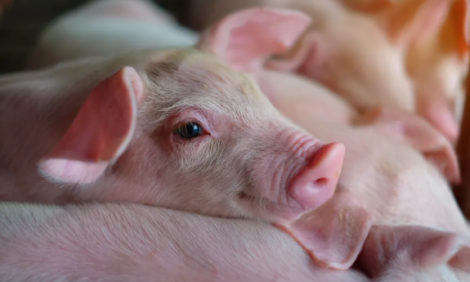



Brazil/Mexico Pork Industry Overview, August 2003
By USDA, FAS - This article provides a summary of pork industry data from the USDA FAS Livestock and Products Annual 2003 reports for Brazil and Mexico. Links to the full reports are also provided. The full reports include all the tabular data which we have omitted from the summaries.
Brazil
Executive Summary
Pork production is forecast to increase in 2004, although at a lower rate than in the past few years, mostly driven by expansion of pork exports. Pork exporters have combined competitive prices with aggressive market promotion efforts in new markets to offset the drop in pork exports to Russia due to the Russian import quotas.
Current macro economic indicators suggest that economic growth will pick up early in 2004, reflecting the results of strong measures in fiscal and monetary policies taken in 2003 to curb inflation rates and the public deficit. The improvement of the economy in 2004 is expected to lower the unemployment rate and increase disposable income, which could stimulate domestic consumption of beef and pork.
Pork Production
Review of 2003. Post revised pork production to increase by only 1.4 percent in 2003. The lower increase in production results from poor domestic demand for pork, higher feed costs during the first quarter of the year, and difficulties with the Russian market due to sanitary problems and the new import quota. Pork production will likely continue to increase in the center-west compared to the traditional southern region because of new investments in sow production, relatively lower feed costs, and local government credit and tax incentives.
Outlook for 2004. Post forecasts pork production to increase by 2.7 percent in 2004 because of higher domestic demand and continued expansion in pork exports to a broader, diversified market. This projection assumes only a moderate increase in feed costs since the new Crop Plan announced for 2003/04 injects higher availability of subsidized credit to increase corn production.
Consumption
Domestic pork consumption in 2003 is expected to remain the same as in 2002, despite the efforts of meat packers to promote domestic demand, because of the loss in the consumer purchasing power, higher rates of unemployment, and competing meat alternatives, mostly from chicken. The outlook for 2004 calls for a small increase in domestic demand as current economic indicators show growth beginning in the first quarter of next year, inflation under control, and a reduction in unemployment rates due to major social projects designed to increase income and improve the conditions of the poor.
Pork utilization in Brazil is estimated at 70 percent industrial/processing, and 30 percent fresh consumption. A promotional campaign to increase fresh pork consumption, which started in the South, has expanded to other major cities in the Southeast. Pork producers remain concerned about the seasonal trend of fresh pork consumption in Brazil which is concentrated during the winter months (June-August), and are trying to address this concern with their campaign to promote the benefits of pork consumption year-round. Pork producers are trying to close the gap between the regions of Brazil in terms of pork consumption. Currently, per capita pork consumption is concentrated in the South with per capita consumption at 18 kilograms, and Southeast at 15 kilograms, while the Center-West (11 kilograms) and Northeast (6 kilograms) regions consume less pork.
Trade
Pork exports are projected to increase in 2004, at the same rate as this year. According to trade sources, pork exports are still too concentrated in the Russian market, but expansion to other non-traditional markets are increasing through sanitary negotiations and aggressive market promotion.
The volume of pork exports during Jan-Jul 2003 increased by 21 percent, but overall exports for the entire year are expected to increase by only 5 percent over the 2002 exports. Most pork exports occurred during the first half of 2003, and, according to trade sources, Brazilian exporters were holding high stocks in the Russian market before the new import quota entered into effect. The value of pork exports during Jan-Jul 2003 increased by 12 percent, and the average price of pork exports during Jan-Jul 2003 reached US$1,026, down 8 percent from the
same period in 2002.
Further Information
To read the full report, please click here (PDF format)
Mexico
Executive Summary
The trend toward vertical integration and larger hog operations continues in Mexico. Hog inventories are on the rise as producers anticipate rising demand for pork as the Mexican economy strengthens. Hog production, slaughter, and imports, along with imports of pork, are all forecast slightly higher in 2004 as the improving quality and consistency of pork products helps to spur demand. Despite the continued growth in hog production in Mexico, Mexico’s pork producers have expressed concern over the potential for rising imports of hogs and meat from the United States and have petitioned the Government of Mexico to conduct an antidumping investigation on U.S. pork exports.
Pork Production
Production for CY 2004 is forecast slightly upward from the previous year’s estimate as the
trend toward vertical integration and more modern production practices continues. For CY
2003, production growth among larger producers was tempered by higher feed costs.
Independent middle-sized operations account for only a small portion of swine production
and many are purebred breeders. There are large numbers of small producers who produce
for self-sufficiency or sales at the village level.
Among the vertically integrated operations, there are associations and cooperatives of mid-sized producers who supply the larger processing plants, allowing them to reduce costs considerably and therefore increase effic iency and productivity. Improved productivity from vertically integrated operations brought swine inventories up during CY 2003. Inventories are expected to continue building through the first part of CY 2004 to meet anticipated stronger consumer demand from an expected strengthening of the economy.
Consumption
Pork consumption continues to grow modestly. Consumption growth is hampered by the inconsistent quality of pork and pork products in Mexico, which ranges fro m world-class to products produced in unregulated village level slaughter facilities. As the trend toward vertical integration in the industry continues, the quality and consistency of pork products is expected to improve. Pork faces stiff competition from beef and poultry among Mexican consumers, some still view pork as a health risk.
Trade
Hog imports for CY 2003 have been revised upward by 25 percent due to attractive U.S.
prices and the recent elimination of the anti-dumping tariff on live hogs. CY 2004 imports
are expected to continue at the same level as imported live hogs face competition from
domestic hog production.
Imports of live hogs for slaughter continue to be limited to a
single border crossing point at Eagle Pass, Texas. Pork and pork product imports for CY
2004 are forecast to increase modestly reflecting U.S. pork’s price and quality
competitiveness. Mexico remains a strong market for U.S. pork variety meats, lard, and
greases. Pork imports for CY 2003 are revised downward reflecting the pace of imports to
date. Imports for CY 2002 are revised downward reflecting official data.
Domestic sausage companies continue to use more imported U.S. pork variety meats and
mechanically de-boned poultry meat due to attractive prices and high quality. Domestically
produced sausages containing imported ingredients, as well as imported sausage, continue
to gain market niches in Mexico, particularly among mid and upper-income consumers.
While animal health concerns and relatively high prices have limited Mexican pork exports,
exporters have established a small niche in Japan. The Mexican pork industry is hopeful that
a proposed free trade agreement with Japan will lead to expanded exports in the future.
Further Information
To read the full report, please click here (PDF format)
List of Articles in this series
To view our complete list of Livestock and Products reports, please click hereSource: USDA, Foreign Agricultural Service - Annual Livestock and Products Report - August 2003








